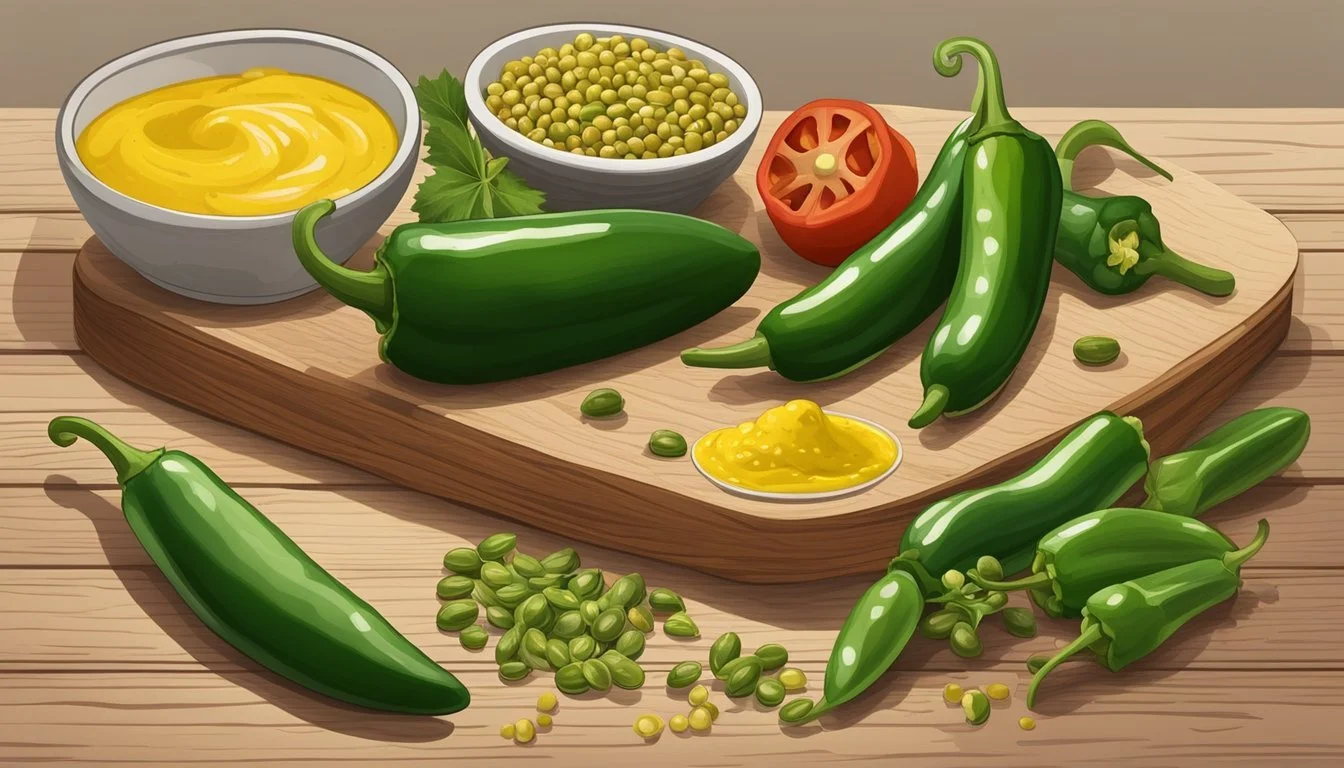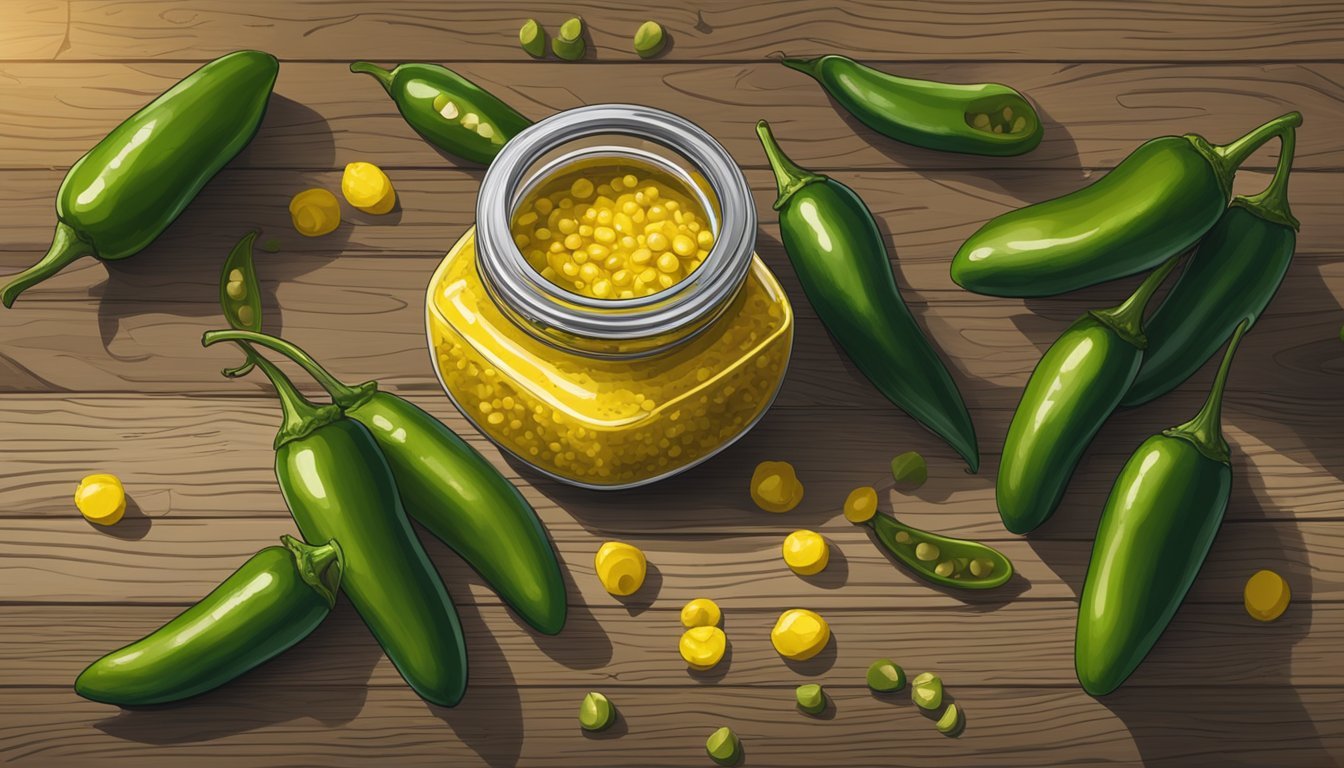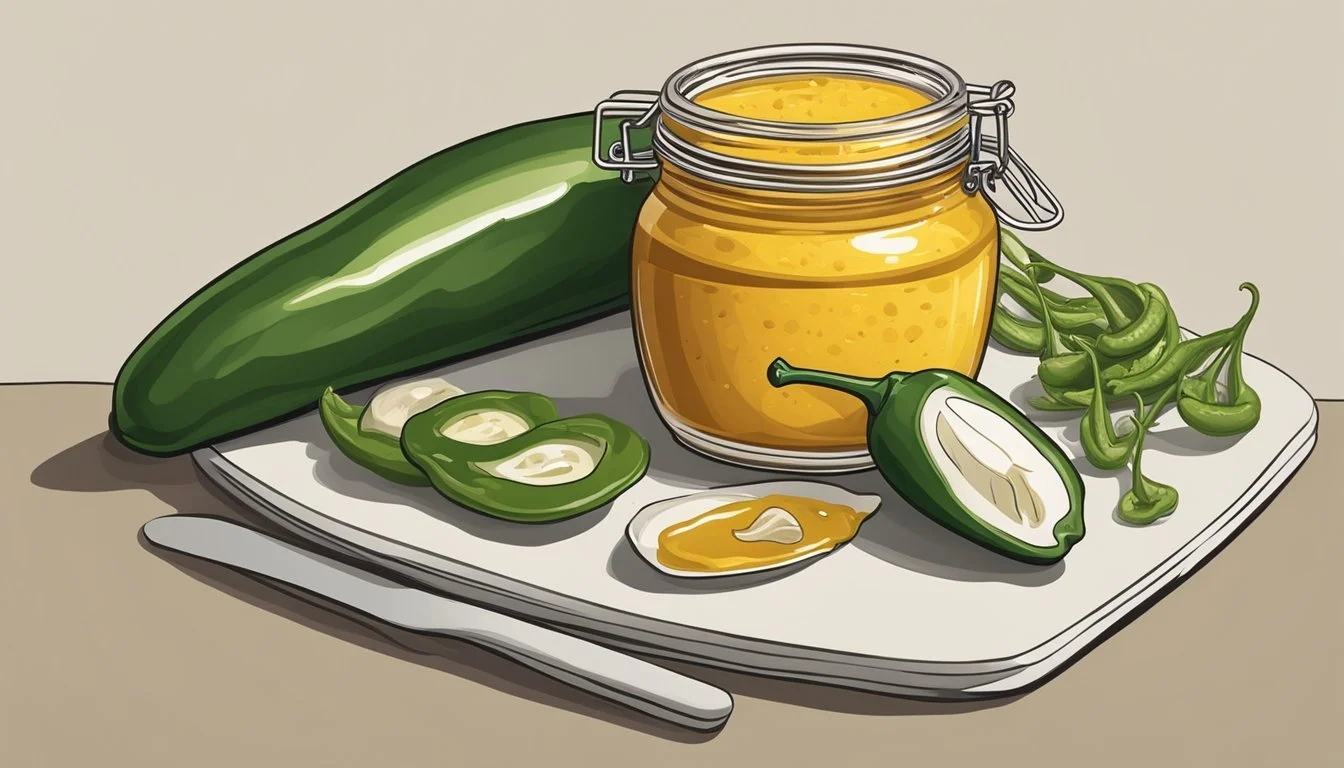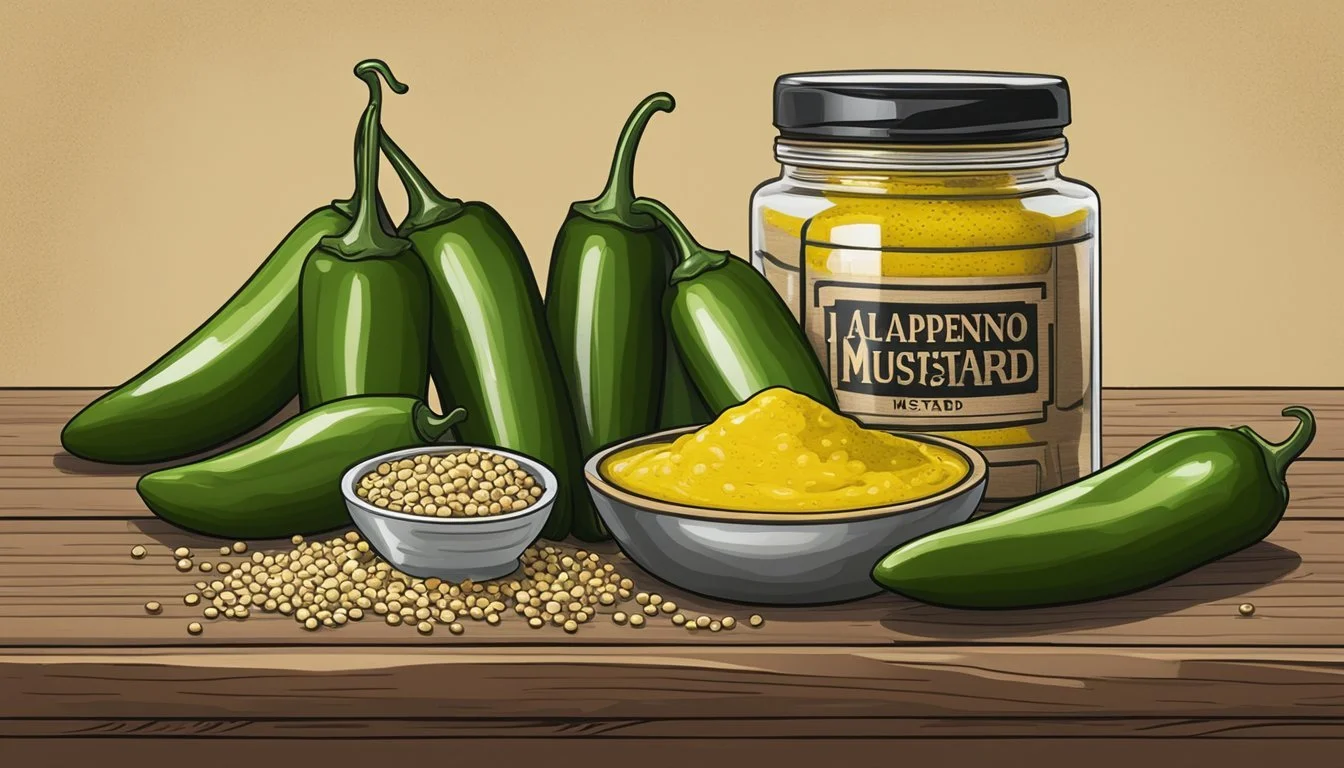Jalapeno Mustard Substitutes
Ideal Alternatives for Spicy Condiments
Jalapeño mustard offers a unique combination of piquant heat and tangy undertones, making it a popular condiment to enhance the flavor of sandwiches, dressings, and marinades. However, for those sensitive to its fiery kick, or when this specialty item isn't available, knowing suitable substitutes is beneficial for maintaining the desired taste profile in recipes.
Substitutes for jalapeño mustard can vary based on the aspect one aims to replicate, whether it’s the heat, texture, or flavor. Options such as hot sauce made from jalapeños, yellow mustard mixed with finely diced chili peppers, or even a spicy brown mustard can serve as adequate replacements. Each alternative carries a flavor that can mimic the zest of jalapeño mustard to some extent while allowing cooks to adjust for heat and ingredient availability.
When it comes to replacing jalapeños in the mustard, alternative peppers like Fresno or Anaheim can be used. They impart their own distinct flavors without overpowering the mustard base. For those looking to dial down the spiciness, bell peppers combined with a dash of hot sauce can offer a milder version. In every instance, it's about balancing flavors to achieve a harmonious blend that complements the dish's intended taste and satisfies the palate.
Understanding Heat and Flavor Profiles
In the realm of cooking, the nuances of heat and flavor are paramount, especially when considering jalapeno mustard substitutes. Proper understanding allows for an accurate match in terms of spiciness and taste.
Scoville Scale and Heat Tolerance
The Scoville Scale is a measurement of a pepper's heat level, represented by Scoville Heat Units (SHU). Jalapeno peppers typically range from 2,500 to 8,000 SHU, aligning with a moderate heat tolerance for many consumers. The heat tolerance refers to how much capsaicin—a compound responsible for spiciness—a person can handle without discomfort. Understanding this scale aids in selecting an appropriate substitute that aligns with desired heat levels.
Flavor Characteristics of Jalapenos
Jalapeno peppers are known for their vibrant, grassy flavor with a brightness that complements a variety of dishes. They also possess a distinctive level of spiciness that doesn't overshadow their flavor. When selecting a substitute for jalapeno mustard, identifying a pepper with a similar flavor profile ensures a well-rounded balance between heat and taste.
Key flavor notes: Bright, grassy, slightly tangy
Heat profile: Moderate spiciness without excessive heat
Importance of Texture and Aroma in Substitutes
While flavor and spiciness are crucial, the texture and aroma of a jalapeno also significantly influence mustard substitutes. Jalapenos have a firm, crisp texture which should be mirrored by the substitute to maintain the integrity of the dish. The aroma, while less pronounced than flavor, contributes a fresh, vegetal scent that subtly enhances the overall sensory experience. Hence, a suitable substitute should not only match the heat and flavor but also complement the texture and aroma of the original ingredient.
Desired texture: Firm, crisp
Aroma contribution: Fresh, vegetal
Natural Substitute Options
In seeking alternatives to jalapeno mustard, one considers various peppers for their heat level, flavor profile, and availability. The following subsections offer a detailed guide on natural pepper substitutes appropriate for different palates and recipes.
Serrano Peppers as Substitutes
Serrano peppers serve as a near-perfect replacement for jalapenos. They are slightly hotter, ranking between 10,000 to 23,000 on the Scoville scale, yet bear a similar flavor profile. Replace jalapenos with serrano peppers in a 1:1 ratio for salsas and marinades to maintain a consistent texture and flavor continuity.
Milder Alternatives: Bell and Banana Peppers
For those desiring less heat, bell and banana peppers present a suitable substitution. Bell peppers, with 0 SHU, offer sweetness without the spice, while banana peppers, ranging from 0 to 500 SHU, provide a mild tang. Use these in greater quantities compared to jalapenos to achieve the desired flavor without the heat.
Bell Peppers: Sweet, no heat.
Banana Peppers: Mild tang, very little heat.
Poblano and Anaheim Peppers Choices
Poblano peppers and Anaheim peppers are excellent choices for those who like a milder heat. Poblanos offer a deeper, sometimes smoky flavor with a gentle warmth (1,000 to 2,000 SHU), while Anaheims have a comparable mildness (500 to 2,500 SHU) with a hint of sweetness.
Poblano: Richer flavor, mild spice.
Anaheim: Mild sweetness and heat.
Hotter Variants: Habanero and Fresno Peppers
For a spicier kick, opt for habanero or Fresno peppers. Habaneros pack a significant punch, boasting 100,000 to 350,000 SHU. They should be used sparingly to avoid overwhelming dishes. Fresno peppers, similar in shape to jalapenos, offer a fruity and smoky note with a heat range akin to serranos (2,500 to 10,000 SHU).
Habanero Peppers: Intensely hot, fruity notes.
Fresno Peppers: Moderate heat, smoky undertones.
Processed and Dried Pepper Options
When seeking alternatives to jalapeño mustard, processed and dried peppers offer concentrated flavors and varied heat levels, suitable for adjusting the piquancy in recipes.
Cayenne Powder and Smoked Variants
Cayenne powder is a prevalent substitute emanating intense heat. With a Scoville Heat Unit (SHU) between 30,000 to 50,000, it's important to use this fiery condiment sparingly when replacing jalapeño. Smoked paprika, a distinct variant made from smoked, dried and ground peppers, adds a complex, smoky flavor to dishes, pairing especially well with mustards meant for marinades or barbecue sauces.
Cayenne Pepper Powder: Use approximately ¾ teaspoon to replace one jalapeño.
Smoked Paprika Powder: Incorporate in moderation to taste, mindful of its impactful aroma.
Using Chipotle and Red Pepper Flakes
Chipotle peppers, which are smoke-dried jalapeños, maintain the original flavor profile while introducing a deep smokiness. This makes them an excellent choice for a substitute in mustards meant for meats and robust dishes. Red pepper flakes, on the other hand, are crushed dried cayenne peppers that deliver a variable heat and texture, proving effective in mustard recipes that can embrace a speckled appearance.
Chipotle Peppers: Crush or blend into a fine powder for a direct 1:1 substitution.
Red Pepper Flakes: Start with a pinch and adjust according to desired heat.
Paprika: A Mild Yet Flavorful Substitute
Regular paprika is derived from dried sweet bell peppers, offering a much milder heat compared to cayenne. It can provide a colorful addition to mustard blends while keeping them palatable for those sensitive to spice. Smoked paprika shares this milder heat but with an added smoky character.
Paprika: Use a 1:1 ratio when replacing jalapeño mustard for color and a hint of sweetness.
Smoked Paprika: Combine subtlety and smoke, also in a 1:1 ratio, adjusting for personal taste preference.
Canned and Pickled Alternatives
When one considers substituting jalapeno mustard, canned and pickled products offer a variety of flavors and heat levels suitable for different dishes. These alternatives provide convenient and often longer-lasting options.
Pickled Jalapenos Versus Other Pickled Variants
Pickled jalapenos are a staple in many cuisines, offering a balanced heat with a vinegary bite. They are typically sliced into rings, which allows the pickling brine, often consisting of vinegar, garlic, and various spices, to permeate the peppers. This results in a pronounced flavor that can substitute for jalapeno mustard effectively.
Other pickled variants, such as banana peppers or canned jalapeno slices, may present a milder heat and a different flavor profile but can still provide a similar texture and tanginess. When replacing jalapeno mustard with pickled peppers, one can usually use a 1:1 ratio, though adjustments can be made according to personal heat tolerance.
Canned Pepper Varieties
Canned peppers offer a less intense but still flavorful alternative to fresh peppers. Options include mild green chiles or diced roasted red peppers, which can impart a sweet and smoky taste to dishes. These products are generally softer in texture compared to pickled options, but they work well in sauces, dressings or as a condiment. For those looking to replicate the heat of jalapeno mustard, one might need to add a small amount of chili flakes or hot sauce to achieve the desired spiciness.
Pepperoncini: A Tangy Option
Pepperoncini are mild, tanned green Italian peppers often found in salads and pizzas. Pickled pepperoncini provide a tangy and slightly sweet flavor with a crunchy texture, making them an ideal addition to sandwiches or as a garnish. Their heat is considerably lower than that of a jalapeno, so they cater to those preferring a milder kick. When using pepperoncini as a substitute, they can often complement the other ingredients without overpowering the dish, although one should consider the textural differences they may introduce.
Non-Pepper Flavor Enhancers
When looking for substitutes for jalapeño mustard that don't involve peppers, there are several robust alternatives that can impart a similar lively zest to recipes. These options can add heat, tanginess, or a depth of flavor that enhances dishes in a way akin to the original condiment.
Mustards with a Kick
For those aiming to retain the characteristic tang of jalapeño mustard without the pepper component, spicy brown mustard or hot English mustard can be an excellent choice. These mustards provide a sharp, pungent taste that brings intensity to dishes. It's important to consider the heat, so start with a small amount and adjust to taste.
Horseradish mustard: A zesty option with a sinus-clearing kick.
Wasabi mustard: Offers an intense heat that dissipates quickly, similar to jalapeños.
Hot Sauce and Taco Seasoning Mixes
Hot sauce can be a dynamic addition to a recipe calling for jalapeño mustard. When selecting a hot sauce, it's crucial to choose one that complements the other flavors in the dish. Here, vinegary-based hot sauces can mimic the acidic note of mustard, while others might contribute a fruity or smoky twist.
Tabasco sauce: A classic choice that adds heat and vinegar sharpness.
Cholula Green Pepper: A hot sauce with a milder heat profile and added spices.
For a more complex seasoning, taco seasoning mixes offer a balance of heat and savory spices, which can bring an unexpected yet harmonious twist to various recipes.
Using Condiments and Spices Creatively
When jalapeño mustard isn't available, turning to other condiments can be a savvy move. Spicy ketchup or chipotle mayo might add both moisture and a spiced complexity to savory applications. Additionally, spices such as cumin or chili powder can recreate the southern warmth typically introduced by jalapeños in mustard.
Cumin: Earthy and slightly spicy, it adds depth without overt heat.
Chili Powder: Constructs a gentle heat and pairs well with other condiments for a full-flavored experience.
Strategic use of these condiments and spices can impart a rich palate of flavors, satisfying the need for a jalapeño mustard alternative. They can each be explored within recipes to establish the desired flavor profile.
Incorporating Substitutes in Recipes
When selecting substitutes for jalapeño mustard in recipes, it’s important to carefully adjust the level of heat and balance the flavors to suit various dishes, such as soups, salsas, and salads.
Adjusting Heat in Soups and Stews
In soups and stews, the heat level directly impacts the overall taste experience. To modulate this:
Start with milder peppers, such as Anaheim or Poblano, for a gentler warmth.
For a bolder presence, incorporate a touch of cayenne pepper or chipotle powder. Use a 1:4 ratio of ground chipotle powder to fresh jalapeño as a guide.
Balancing Flavors in Salsa and Mexican Cuisine
Mexican dishes like salsa, tacos, nachos, and quesadillas rely on the balance of flavors and heat. Essentials for the balance include:
Bell peppers for a mild profile, while adding serrano peppers if more spice is preferred.
Use fresh peppers such as jalapeños or serranos in a 1:1 ratio for pico de gallo or guacamole to maintain a lively kick.
Creating Exquisite Salads and Fillings for Stuffed Peppers
Salads and stuffed peppers benefit from the crunch and zing of jalapeños.
Substitute with diced bell peppers or peperoncini for less heat and more sweetness.
When preparing fillings, use finely chopped habanero peppers sparingly for significant heat or banana peppers for a subtler flavor profile.
Conclusion
In the realm of culinary innovation, finding the right substitute for jalapeño mustard can be a simple yet crucial task. It requires a balance of heat, tang, and flavor to maintain the integrity of the original ingredient while providing a suitable alternative.
Substitutes for Jalapeño Mustard:
Mild heat: One may consider dijon mustard with a dash of smoked paprika for a similar spice level and added smokiness.
Medium heat: Hot sauce-infused mustard can offer a versatile flavor profile with adjustable heat, depending on the chosen hot sauce.
Robust heat: For those desiring greater intensity, mustard mixed with cayenne pepper or hotter chili powders suits well.
No heat: When heat isn't desired, honey mustard or sweet mustard can provide flavor without the burn.
One must also consider the recipe context and personal taste preferences when selecting jalapeño mustard substitutes. The key is to not be afraid to experiment with quantities and combinations, ensuring the substitute not only mimics the heat but also complements the dish's overall flavor profile.
With thoughtful considerations and these suggested alternatives, chefs and home cooks alike can confidently navigate the absence of jalapeño mustard in their recipes, ensuring delicious outcomes that are both respectful to the original dish and tailored to personal preference.








